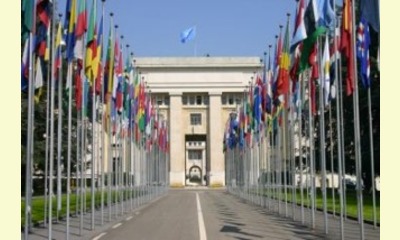|
|
Culture of Peace Advocacy at the UN: Education about Peace Education
un articulo por Oliver Rizzi Carlson
The official international efforts for the creation of a culture of peace include the International Year for a Culture of Peace, the Declaration and Programme of Action on a Culture of Peace, and the Decade for a Culture of Peace, which ended just last year. They come from UNESCO and the UN itself, and serve as tools and stepping-stones to promote peace education policies within the UN now and into the future.

click on photo to enlarge
This year, peacemaking and peacebuilding traditions were taken into account during a consultation of the UN Office of the High Commissioner on Human Rights about cultural rights and heritage; peace education and empowerment were promoted within the context of a report on violence against children as well as a draft resolution on children living and or working on the street; and synergies were created for the promotion of the Declaration on Human Rights Education and Training adopted at the Human Rights Council last month – to cite just a few examples.
With the creation of a Culture of Peace Working Group in Geneva, we are now working together with other NGOs to focus on the Human Right to Peace. The Advisory Committee of the Human Rights Council is to prepare a draft declaration on the right of peoples to peace.
The Advisory Committee states in its progress report that “a right to peacewithout reference to education is inconceivable,” mentions education as a “necessity for building a culture of peace" and states that “all peoples and individuals have a right to comprehensive peace education.”
It is now up to us to make sure that these considerations are given real import in the drafting of the declaration, and that they are infused with content and a substantial understanding of those concepts.
Through these efforts, we are supporting policy makers in supporting peace educators – what I call “the process to the process.” We are working with institutions to create the political infrastructure to enable and facilitate the processes of peace education. And it is a growing number of us contributing our stream to the river on which peace education will be increasingly recognized and supported at the institutional level, making it a guiding principle and a way of living for the current and future generations.
|








|
DISCUSSION
Pregunta(s) relacionada(s) al artículo :
Peace education at the United Nations, how does it work?
* * * * *
Comentario más reciente:
[Editor's note]: This is a continuation of the article by Oliver Rizzi Carlson, Culture of Peace Advocacy at the UN.
In the historic, international hallways of the United Nations, multitudes of people from every country in the world are busy going to meetings, addressing agenda items relevant to their governments and organizations, and making contacts. Lists are set, events are scheduled… agendas are largely inherited and predictable, presenting many issues and objectives that people have been working toward for a long time: goals of peace, prosperity, equality, justice. And yet, agendas still provide an incredible space to speak about the process by which those desires are achievable. Most of the time, documents just fall short of that transformative element, seeming to be longing for it. Peace education is seldom included; but once mentioned, it is immediately recognized for its relevance and importance. The “whats” are many and detailed in the world of international conference-making; the expertise of the “how” is a welcome newcomer to the discussion.
Advocating for peace education in the midst of governments, international organizations and even NGOs, few of which promote peace education directly, appears as a lonely journey. But as soon as one starts to speak about it, people’s eyes light up, new ideas and proposals flow, and diverse groups gather to talk about it further – it seems the momentum is building very quickly to create a real consciousness about peace education at the international and institutional level. Many also say it is “refreshing” to see youth doing this work. . ... continuación.

|
|









